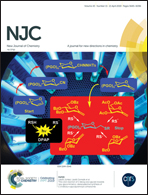A quantitative description of photoluminescence efficiency of a carbazole-based thermally activated delayed fluorescence emitter†
Abstract
A reliable quantitative description of photoluminescence efficiency is crucial for designing and developing new-type thermally activated delayed fluorescence (TADF) emitters. In this contribution, we computed the conversion and decay rates of a novel TADF-active molecule, 2-(9H-carbazol-9-yl)-thianthrene-5,5,10,10-tetraoxide (CZ-TTR), involving the lowest singlet excited S1 state and triplet excited T1 state. The efficiency of total fluorescence containing prompt fluorescence and delayed fluorescence was obtained correspondingly. The present results reveal that the rate of reverse intersystem crossing from T1 to S1 is calculated to be slightly larger than the radiative and non-radiative decay rates of the S1 state at 300 K temperature, thus resulting in an occurrence of delayed fluorescence. Additionally, the total fluorescence efficiency is estimated to be 54.5%, which agrees very well with the photoluminescence quantum yield of 56.7% observed experimentally. It is also found that the dominant charge transfer characteristics in the S1 and T1 states produce a small energy difference between the two states, and consequently an efficient reverse intersystem crossing process and a high fluorescence efficiency.



 Please wait while we load your content...
Please wait while we load your content...